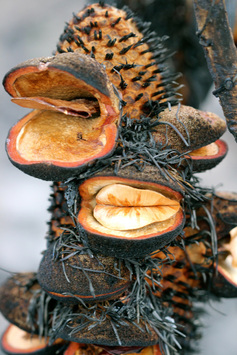|
At a first glance it looks black, vast and barren - but take a closer look and new life is beginning…
You’ve got to wonder how life returns after fires. Yet, that’s exactly what’s happening now, life is being restored. Many of our local plants, especially those in the heathland, are well equipped to cope with fire and indeed depend on it for their survival. If you’re a fire adapted plant species, the way you cope with fire makes you either a ‘seeder’ or a ‘re-sprouter’. Seeders regenerate after fire from seed which they store in the soil or in their fruits. Re-sprouters are a little tougher and are able to reshoot from protected growth buds in their trunks, branches or roots. If you’re super adapted to fire, you might be known as both a seeder and a re-sprouter. Our Wallum Banksias are currently showing off these talents in the blackened heathland behind Lake Ainsworth. Their cones have all burst open exposing what looks like lots of empty hungry mouths (pictured). On the ground their papery seeds are scattered in the nutrient rich soils… waiting for the rain. And at the base of old dead looking trunks new growth is appearing from little growth buds which were protected from the fire. These impressive and hardy species and can live for up to 100 years. The other super tough species, which was first to recover on our Lennox fire ground was the Grass Tree (pictured). It’s a re-sprouter and there are hundreds of them coming up like a crop along the Coast Road. They are likely to produce a spectacular mass of stalked yellow flowers in the coming months. Unfortunately, not all plant species are such stoic survivors of fire. Of particular concern are those species which are killed in fire and only regenerate from seed, the ‘seeders’. For these species to survive, the length of time between fires is critical. There needs to be enough time for these plants to grow and produce seed before the next fire. And to complicate matters further, if there’s too much time between fires old plants can die and their seeds can rot in the ground. The areas burnt in the recent Lennox fires are home to three main plant communities, wet heathland, wallum heathland and coastal wetland. In a perfect world which maintains biodiversity, and looks out for all the ‘seeders’, burns need to happen in mosaic patterns at intervals which suit all the species. For the heathlands the recommended interval is between 8 to 20 years, and for the wetlands it’s between 15 and 30 years. With reports of around 20 years since our last big fires, we should have it covered for now. None of our Landcare sites were affected by the fire. But we do expect to see an increase in little creatures looking for temporary homes! *Special thanks for this months article goes to local Firie and Landcarer John Hutton. |
Article published in the Lennox Wave February 2014





